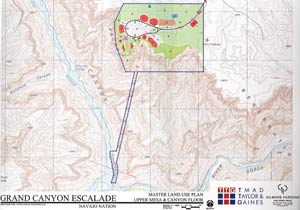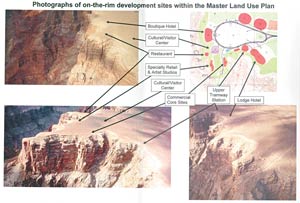Targeting the Confluence
Group unveils sweeping plans for project at Grand Canyon sacred site
By Cindy Yurth and Duane Beyal
Navajo Times
WINDOW ROCK, June 14, 2012



(Special to the Times - Donovan Quintero)
TOP: A water offering is performed by medicine man Malcolm McCabe, center, green jacket, May 25 at the Confluence where the Little Colorado River meets the Colorado River in Grand Canyon.
SECOND FROM TOP: This plan for the proposed Grand Canyon Escalade provided by Confluence Partners LLC shows the layout of the development.
THIRD FROM TOP: This illustration provided by Confluence Partners LLC shows where the hotel, restaurant and other parts of the proposed Grand Canyon Escalade project would be if approved.
Representatives of the group, including State Sen. Albert Hale, D-Window Rock, who is serving as spokesman for the group, say the project would provide up to 2,000 jobs and bring in an estimated $50 million to $95 million annually to the Navajo Nation.
The plan for the "Grand Canyon Escalade" is scaled down from the initial sketch signed off on by President Ben Shelly in a memorandum of understanding last year, which covered 5,000 acres, but still would cover about 420 acres.
The project plans include multiple motels, shops and restaurants, a tramway to the bottom of the canyon, a 1,400-foot elevated river walk and Navajo cultural center, amphitheater and museum.
Bodaway/Gap Chapter last month passed two resolutions opposing the development, but the stronger one, requesting the Navajo Nation to "cease and desist from any and all negotiations with Confluence Partners," was not signed by the chapter officials.
Chapter President Billy Arizona said it "named too many names." There was also some question as to whether it was a legitimate resolution as it was introduced first as an amendment to the first resolution and later brought back as a stand-alone.
A locally based group, Save the Confluence, opposes the Escalade, saying it would violate one of the most sacred sites in Navajo cosmology, disrupt the environment and disturb the lives of traditional herders living on the canyon rim.
The group also doesn't think Confluence Partners is the best choice to develop the sensitive land, citing its inexperience as a new company and founding member Lamar Whitmer's history as head of the Maricopa County Sports Authority.
Whitmer was charged with misappropriation for allocating himself $40,000 in per diem expenses in a single year, but a court determined the authority's by-laws permitted the expenditures.
In a meeting with the Navajo Times last week, the Confluence Partners said the plan would actually allow for better protection of sacred sites, and they're working to convince the locals that the benefits to the community would outweigh any disruption caused by the development.
"For a long time we couldn't get information out because the negotiations with the Navajo Nation were under a confidentiality requirement," said Mike Nelson, one of the Confluence partners.
Nelson is a former Arizona Superior Court judge and staffer for former President Peterson Zah.
Added Albert Hale, "Now we will be out there making presentations."
According to the "frequently asked questions" section of a booklet provided by the partners, Whitmer first approached Hale about developing the confluence in 1997 while Hale was president of the Navajo Nation. At that time, the area was under the Bennett Freeze and development was prohibited. The area has been under the freeze for 40 years, Hale said, and this project is one way to bring in infrastructure and jobs.
The master plan states the partners will hold a series of public hearings on the project, "leading up to the chapter voting on a resolution of support for the project."
Shelly will appoint a five-member stakeholder group to "assist the Navajo negotiating team and insure that the local residents' interests are represented."
Confluence Partners say the certified chapter has little to lose and much to gain in approving the project.
"In addition to the chapter's business activity tax," reads the master plan, "it is proposed that one-third of the Navajo Nation revenue be dedicated to the rehabilitation of the Bennett Freeze area."
Once approval is obtained at the chapter level, the partners told the Times, the project will go before the Western Agency Council and then the full Navajo Nation Council before the project could proceed. It would be subject to the usual environmental and archeological clearances.
Still in negotiation is a "master agreement" between Confluence Partners and the tribe, according to the president's office.
Deswood Tome, an assistant to President Ben Shelly, sat in on the meeting with the Navajo Times and said the project hinges on local support.
The partners say they will ask the Navajo Nation to provide a paved 27-mile access road from U.S. Highway 89 to the site along with water and electricity, which could be tapped by local residents who currently don't have utilities.
It is the responsibility of Confluence Partners to raise funds for the project from private investors and elsewhere, Hale said.
As far as protecting the sacred area around the Confluence and prayer sites on the canyon rim, the partners say development will actually help Navajos monitor the site.
For example, a point on the canyon rim that is sacred to several tribes will be blocked except for tribal members.
"Visitors will be restricted to the elevated walkway and the restaurant which are 300 feet from the Confluence of the Rivers," the master plan reads. "Existing prayer sites will be protected with landscape buffers to protect their privacy and access will be limited to Navajos only."
According to the plan, Hopi sacred sites will not be impacted "at all."
The plan points out that, at present, the National Park Service permits rafters to dock at the confluence and swim in the Little Colorado, so the area is already being used by tourists.
"It's time the Navajo people enjoy a share of Grand Canyon business!" reads the plan.
Although Grand Canyon National Park Superintendent Dave Ubueraga told the Times in a previous interview the National Park Service would oppose any development on the canyon floor, the partners state in the plan they've received no official communication from the park service and "plan to work with the Park as good neighbors."
Based on visitation to other tourist sites at the Grand Canyon, the partners project 1.5 million visitors a year, or 10,000 "on a busy day."
The traffic would be a boon for local craftsmen who could sell their wares at a covered vending area by the parking lot, the plan states.
The developers estimate construction of the massive project would take 12 to 18 months, and the Grand Canyon Escalade could be open as soon as 2015.
Bodaway/Gap Chapter member Pauline Martin Sanchez said she has seen the master plan and attended several meetings on the subject, and still doesn't like it.
As an entrepreneur herself, she doesn't think it makes good business sense.
"The Navajo Nation is already building that big casino resort near Leupp," she said. "Why build another luxury hotel to compete with ourselves? Why not run tours to the confluence from the resort they're already building?"

